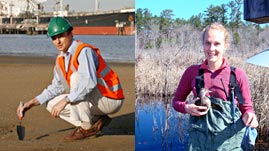Teachers' Domain - Digital Media for the Classroom and Professional Development
User: Preview

Source: Produced for Teachers' Domain
Men and women who work in environmental public health are concerned with anything in the environment that may affect human health, from clean water to polluted air, mercury to mosquitoes. This interactive activity from Teachers’ Domain describes careers in six environmental public health disciplines: exposure assessment, epidemiology and biostatistics, environmental health policy, communication, toxicology, and environmental medicine. Learn about careers in these fields and how environmental public health professionals prevent disease, create safe environments, treat people sickened from environmental exposures, and help the public make healthy decisions.
In the 1970s, people in the city of Woburn, Massachusetts, became concerned about their drinking water. For years, residents had complained about the water, which smelled like bleach and was often murky and rust colored. But when an unusually high number of children started developing leukemia, citizens took action and authorities took notice. Over the next decades, an array of environmental health professionals mapped, investigated, and analyzed the city’s population and water supply. The story of Woburn provides an excellent example of what environmental health professionals do and how they solve real-world problems.
In 1979, acting on the concerns of citizens, environmental engineers and technicians working for the state of Massachusetts sampled drinking water in Woburn and found chemical contamination in two wells. Some residents suspected that the incidence of leukemia in Woburn was linked to the chemicals in the drinking water, but they couldn’t prove it. Epidemiologists—scientists who investigate the environmental factors that cause disease—from the Massachusetts Department of Public Health began investigating the problem. Working in tandem with biostatisticians—experts who design research studies and analyze data related to human health—they confirmed that rates of childhood leukemia in East Woburn were at least seven times higher than expected. Later, environmental regulators and lawyers found that two companies had contaminated the groundwater by improperly disposing of industrial solvents at their facilities in Woburn.
In the 1980s, government regulators ordered the polluting companies to start monitoring the groundwater and fix the problem. These programs required the skills of many different people: toxicologists and chemical analysts to examine water samples for harmful contamination, geologists to map the underlying rock formations, engineers and field technicians to design a remediation program and carry it out, hazardous materials removal workers to dispose of any toxic waste, environmental doctors and nurses to monitor the health of citizens, and regulatory lawyers to make sure that environmental regulations were enforced.
The story of Woburn became famous through a book titled A Civil Action, which was later turned into a movie. More importantly, many environmental health professionals remain on the job in Massachusetts today, safeguarding public health by making sure the water remains clean and safe.
 Loading Standards
Loading Standards Teachers' Domain is proud to be a Pathways portal to the National Science Digital Library.
Teachers' Domain is proud to be a Pathways portal to the National Science Digital Library.
